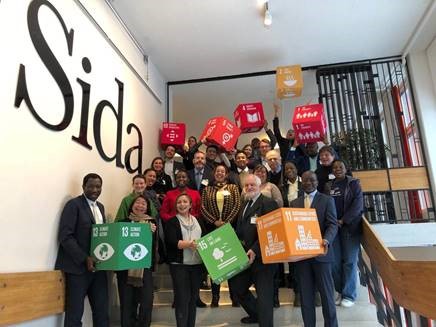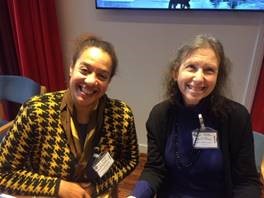

News in 2019
|

Participants of the inaugural GLTN Steering Committee meeting hosted by
SIDA at their Stockholm offices in Sweden.
Vice President Diane Dumashie attended the GLTN steering committee
(see members) in Stockholm, and kindly hosted by Swedish
International Development Agency (SIDA). This is a significant
milestone meeting on several fronts. First, continuing growth of
the network with 80 partner members, this has an impact on the way we
operate. Next, to accommodate the successful and increasing reach
of the GLTN partners activities a new governance structure has been
agreed that will enable greater efficiencies and clearer accountability.
Finally, and above all, it was a pleasure to welcome Mr Victor Kisob,
Deputy Executive Director of UN Habitat, as the new chair of the
Steering Committee. And appreciation was given to UN Habitat for
their continuing support to the network and facilitating the GLTN
Secretariats operations.
Established in 2006, the Global Land Tool Network (GLTN) is celebrating 12 years as an alliance of diverse international organizations that contribute to poverty alleviation and sustainable development through improvements to security of tenure and land governance. The network is an important platform for FIG, and we were instrumental in its formation in 2006, and were amongst the originating partner members.
Over the years FIG members’ have been actively engaged, led by our Council and rolled-out in the work plans of our Commission, Africa Regional Network, and Young Surveyors Networks. In 2018, our contribution was duly acknowledged by the former head of GTLN, Clarissa Augustinus
We have been at the forefront of GLTN activities; on land tool development, on testing and dissemination innovative methods, focusing on urgently needed, and priority land tools, and promoting and facilitating the adoption at scale of land tools and practices that promote tenure security and to develop the capacity needed for fit for- purpose implementation.
The Network is heading into a new programmatic phase III, within a global context characterized by both challenges and opportunities in the land sector. After 12 years of interventions and innovations in the land sector by GLTN partners, it’s noticeable that tenure security has gained momentum in both national and global contexts; and has also generated awareness among decisions makers and beneficiaries at community level, in addition to the progress that land issues have made in the Global agenda- led by the Sustainable development Goals, and supported by the New Urban Agenda.
Accordingly, the meeting aim was set against the backdrop of a common vision outlined in the Strategy plan (2018- 2030), and understanding the strategic objectives for the current GLTN Phase 3 implementation. To assist this debate Diane Dumashie presented an outline of the emerging land environment
Bearing in mind the emerging new challenges in the land sector, including resources and capacity issues, the steering committee discussions centred upon:

Dr Diane Dumashie, FIG Vice-President and Professional Cluster co-lead
in discussion with Ms Jane Katz from Habitat for Humanity and the Urban
Civil Society Cluster co-lead.
Today, there is a global consensus on the need to provide tenure security to achieve the Sustainable Development Goals (SDGs) and the New Urban Agenda. These frameworks offer new opportunities for GLTN partners and the Network to become more relevant in contribution towards addressing tenure security for various purposes including poverty alleviation, food security, gender equality, peace and stability
2019 is an impactful and exciting chapter for GLTN into phase 3. FIG members are a key part of the GLTN network, and working together with partners in the Professional cluster (FIG co-chairs with the Arab Union of Surveyors) and across to clusters (such as Urban, Rural and Academic clusters), we are strategically placed to help countries deliver on the SDG’s steered by the GLTN Stagey documents 2018- 2030 and our own FIG work plans.
Partnership working is key to leveraging resources, GLTN remains grateful to all our donors: the government of Netherlands, Sweden, Germany, Switzerland and Norway and our development partners, IFAD, UNECA and UN Women for their past and continued investment and support to the GLTN Agenda since inception but above all to those from our own FIG network that remain involved.
If you require further information do not hesitate to contact FIG Vice President Diane Dumashie (Co- chair GLTN Professional Cluster)
Diane Dumashie
February 2019